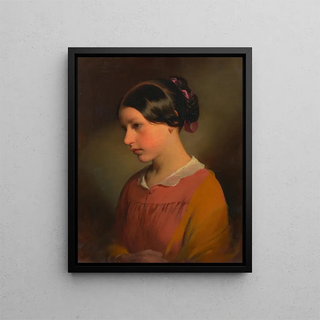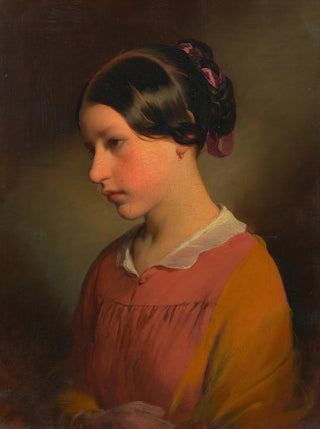Art print | Ludmilla Amerling, daughter of the artist child - Friedrich von Amerling


View from behind

Frame (optional)
Reproduction Ludmilla Amerling, daughter of the young artist - Friedrich von Amerling – Captivating introduction
In the fascinating universe of art, some works transcend time and space, capturing moments of life and emotions of unparalleled depth. "Ludmilla Amerling, daughter of the young artist" by Friedrich von Amerling is one of those creations that invites contemplation. This piece, created in the 19th century, offers an intimate glimpse into the relationship between the artist and his daughter, while reflecting the aesthetic conventions and aspirations of its era. The delicacy of the features, the brilliance of the colors, and the palpable tenderness between father and daughter make this painting a true masterpiece, a testament to paternal love and childhood beauty.
Style and uniqueness of the work
Friedrich von Amerling, master of portraiture, stands out for his ability to capture the essence of his subjects with unmatched finesse. In "Ludmilla Amerling, daughter of the young artist," the artist employs a palette of soft colors, creating an atmosphere that is both serene and warm. The details of the child's clothing, as well as the sparkle in her eyes, testify to meticulous attention to nuances and textures. Every brushstroke seems to tell a story, and the innocence of childhood is beautifully captured in Ludmilla's expression. This painting is not limited to a simple portrait; it evokes a suspended moment in time, a living memory that resonates with anyone who has known familial love.
The artist and his influence
Friedrich von Amerling, born in 1803 in Vienna, is an iconic figure of Austrian Romanticism. His career, marked by numerous portraits of personalities of his time, helped shape the artistic identity of the Austro-Hungarian Empire. Amerling managed to combine tradition and innovation, integrating elements of realism while preserving a poetic dimension in his works. His influence is felt not only in the field of portraiture but also in how subsequent artists approach the representation of childhood. "Ludmilla Amerling, daughter of the young artist"

Matte finish

View from behind

Frame (optional)
Reproduction Ludmilla Amerling, daughter of the young artist - Friedrich von Amerling – Captivating introduction
In the fascinating universe of art, some works transcend time and space, capturing moments of life and emotions of unparalleled depth. "Ludmilla Amerling, daughter of the young artist" by Friedrich von Amerling is one of those creations that invites contemplation. This piece, created in the 19th century, offers an intimate glimpse into the relationship between the artist and his daughter, while reflecting the aesthetic conventions and aspirations of its era. The delicacy of the features, the brilliance of the colors, and the palpable tenderness between father and daughter make this painting a true masterpiece, a testament to paternal love and childhood beauty.
Style and uniqueness of the work
Friedrich von Amerling, master of portraiture, stands out for his ability to capture the essence of his subjects with unmatched finesse. In "Ludmilla Amerling, daughter of the young artist," the artist employs a palette of soft colors, creating an atmosphere that is both serene and warm. The details of the child's clothing, as well as the sparkle in her eyes, testify to meticulous attention to nuances and textures. Every brushstroke seems to tell a story, and the innocence of childhood is beautifully captured in Ludmilla's expression. This painting is not limited to a simple portrait; it evokes a suspended moment in time, a living memory that resonates with anyone who has known familial love.
The artist and his influence
Friedrich von Amerling, born in 1803 in Vienna, is an iconic figure of Austrian Romanticism. His career, marked by numerous portraits of personalities of his time, helped shape the artistic identity of the Austro-Hungarian Empire. Amerling managed to combine tradition and innovation, integrating elements of realism while preserving a poetic dimension in his works. His influence is felt not only in the field of portraiture but also in how subsequent artists approach the representation of childhood. "Ludmilla Amerling, daughter of the young artist"






